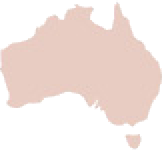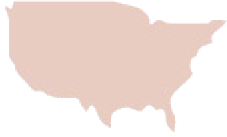
When we first discovered artist Gabrielle Jones's works, we were keen to buy a painting for every room in our homes. We're thrilled to introduce you to another artist whose works will brighten your home, and she's every bit as lovely as you would imagine.
Gabrielle Jones's abstract and expressionist work is all about process. She finds the work unfolds on the canvas in layers as she draws on memories, thoughts, feelings and past experiences while responding to the marks on the canvas itself. It's important for her viewers to feel joyous when viewing her works, as that's how she feels when she's in the creative depths of painting and enjoying the work, so much so that she emphasizes beauty is simply a byproduct of her immersing herself and enjoying the creative process.
Continue on for our chat with Gabrielle on how she decided to make a pivot and pursue art full time, her inspiration, trusting herself and her process and the importance of routine and ritual. We know you're going to love her (and her work) just as much as we do.
Shop Gabrielle's Work

No longer can you simply ask the question “what do you do” for a living? Most people wear many hats! What hats do you wear?
I am a painter and occasional ceramicist who also loves drawing in charcoal and watercolour. I teach workshops and run art retreats (ArtRetreatsInternational) from time to time.
Can you tell us a bit about your path? How did you discover art and decide to pursue it?
I was the fifth kid of seven noisy children, with a sister fourteen months younger than I am. My mum found that if she put me in a corner with paper and pencils, I was quiet for a long time! So I’ve always drawn and painted from about ten years old, self-taught. My first realistic painting was at twelve years of age (of a horse- I was obsessed!)
I took 3 units of art at HSC and was exhibited at CBA in Martin Place and went to do serious courses at University of Sydney but continued painting as soon as I graduated, doing a TAFE course four nights a week. It has always been my love and solace.
A few business and law jobs later, a recession or two and some work in my partner’s Graphic Design business, I realised that the “painting while the kids at school” was never going to happen unless I made a conscious decision. While I was trying to decide, the sun shone through a stained glass window and I took that as a sign and enrolled in the National Art School Full-time. Life is too short to live someone else’s life! I have been a professional artist ever since graduating, working business-related jobs part time when I could, and starting a private art school that was successful for about ten years until I sold it late 2018 to focus on two regional gallery shows scheduled for 2019 (Gosford in February and Muswellbrook in Sept-October).
How would you describe your work?
I would generally be described as a contemporary abstract expressionist. My work explores paint in the material, sensual and psychological sphere and becomes a conduit between the internal and external worlds I experience in contemporary life. For example, elements responding to current politics may be present, or subjects misremembered from travel appear combined with purely abstract expressions of joy or other feelings. The work unfolds on the canvas in layers, drawing on memories, thoughts, feelings and past experiences, and responding to the marks on the canvas itself. My purpose is always to paint and see what happens. There is no planning, except for sizes, medium or colours. The rest happens in the zone.
What do you do to keep creative?
I have a routine for when I go to the studio and what I do when I get there (shut the door, keys in safe dropzone, coffee made, music on, sit in the chair and look at what I left last session). I find being there means my brain knows to turn on and looking with fresh eyes usually tells me where the painting needs to go, and I’m off within about 10 minutes.
I try to go to the studio about 3-4 days a week. If that routine changes, as it has recently with world events, I find it more difficult to start but making it to the studio is key. And so is the music!
Can you tell us about “Becoming”, the meaning behind it and how it came to be?
Becoming is the result of next level of abstraction of work I made during a residency at the Margaret Olley centre of the Tweed Regional Gallery. While there, I painted from Olleys’ Reconstructed studio and her paintings daily and made a number of finished paintings, drawings and watercolours. When back in the studio, I painted from these sources and memory, and “Becoming” was one painting that resulted.
Are there any overall feelings or emotions you hope your artwork conveys?
In general, I want the viewer to feel uplifted — joyous even, which is the feeling I mostly have when in the depths of painting. At its best, there is also beauty (though I don’t aim for that specifically, it’s a product of enjoying the process, being relaxed and somehow, transported to a higher place, if that makes sense). I love and champion beauty, but I feel it needs to be a by-product, not an aim. And the beauty I find is often accompanied by a little ugliness or rawness. That’s the best.
Can you tell us a bit about your process — what sparks a work and where do you turn for creative inspiration? What materials do you work with?
Anything can spark the work, including the materials themselves, a beautiful colour or new medium, how I'm feeling, a glimpse of something on the way to the studio, past drawings, other artists' work etc. That’s all part of my process: to be open, to experience, to feel and reflect. After twenty years of being an artist, I'm at the point that I trust the process of starting and my knowledge enough so that I can let go and be in the flow sooner. That doesn’t mean I don’t get angry at the canvas (especially after a few days break when I think I have forgotten everything) but I’ve found that’s often a sign of the brain switching from everyday left to creative right brain, and that anger can be a very creative energy, so I go with that.
What materials do you work with?
I work mostly with oil paints, increasingly with acrylics (due to safety concerns with my Blòue Mountains studio in winter) with watercolour, charcoal and, recently, a return to clay.
Can you give us 5 words to describe you?
Creative, energetic, determined, classy and fun-loving.
What are your Barnaby Lane picks?
That’s a bit nasty, making me choose! But I love the Tanner chairs (especially the armchairs) and the Cubitt Dining Table. I can also see myself on the leather swings some day.










